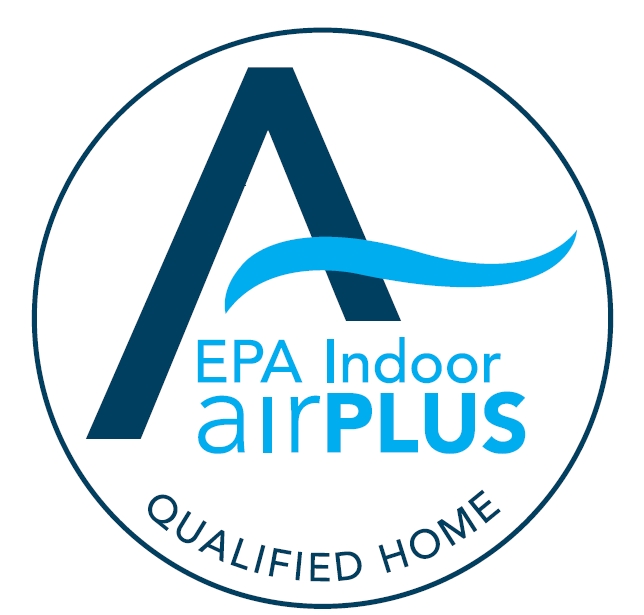EPA Indoor airPlus
Better Environments, Inside and Out
Look for the U.S. Environmental Protection Agency (EPA) Indoor airPLUS and ENERGY STAR labels on your new home. Reduced indoor air pollutants help protect your family inside. Reduced greenhouse gas emissions help protect the air outside.
Homes with the Indoor airPLUS label are designed for improved indoor air quality compared to homes built to minimum code.*
Why does indoor air quality matter?
People are increasingly concerned about mold, radon, carbon monoxide, and toxic chemicals in their homes. In fact, EPA studies show that levels of air pollution inside the home are often two to five times higher than outdoor levels. And poor indoor air quality can lead to eye irritation, headaches, allergies, respiratory problems such as asthma, and other serious health problems.
How can building practices help improve indoor air quality?
Builders can use a variety of construction practices and technologies to decrease the risk of poor indoor air quality, including careful selection and installation of moisture control systems, heating, ventilating and air-conditioning (HVAC) systems, combustion-venting systems, and building materials. But it’s not easy for homebuyers to keep track of all the preferred construction details that lead to improved indoor air quality. That’s why EPA created the Indoor airPLUS label. Ask for it on your next new home.
How do homes earn the Indoor airPLUS label?
- Start with ENERGY STAR: A home must first be designed and built to earn the ENERGY STAR—the government-backed symbol for energy efficiency. The result is a home that is significantly more energy efficient that a home built to minimum code, helping reduce greenhouse gas emissions.
- Add indoor air improvements: More than 30 additional home design and construction features are included in the Indoor airPLUS label to help protect qualified homes from moisture and mold, pests, combustion gases, and other airborne pollutants.
- Complete the package with independent testing and verification: The home’s energy performance and many key features of Indoor airPLUS are inspected by our independent third-party auditors to ensure that the builder has properly followed EPA’s rigorous guidelines for energy efficiency and indoor air quality.
*Indoor airPLUS construction specifications are designed to help improve indoor air quality (IAQ) in new homes compared with homes built to minimum code. However, these features alone cannot prevent all IAQ problems. Occupant behavior is also important for IAQ. For example, products used in the home after occupancy and smoking inside may both negatively impact the home’s IAQ and the performance of the specified Indoor airPLUS features.
What features are included in new homes that qualify for Indoor airPLUS?
- Moisture Control: Moisture problems can lead to mold and other biological pollutants that can negatively impact health. With Indoor airPLUS, builders use a variety of moisture control features designed to minimize these risks, including improved control of condensation and better roof, wall and foundation drainage.
- Radon Control: Exposure to radon, a naturally occurring radioactive, invisible and odorless gas, is the second leading cause of lung cancer in the United States. In high radon potential areas (which does not include the Northwest Arkansas region), homes meeting the Indoor airPLUS specifications are built with radon-resistant construction techniques. Homebuyers in these areas are also provided with test kits to check radon levels after they move in.
- Pest Management: Residue from pests such as rodents and cockroaches are known to trigger allergy and asthma episodes. With Indoor airPLUS, builders provide a first-line defense against these problems by fully sealing, caulking, or screening likely pest entry points. When these physical barriers are combined with proper pest management techniques, fewer pesticides may be needed.
- Heating, Ventilating and Air Conditioning (HVAC): Poorly designed and installed HVAC systems can lead to comfort and air quality problems. Homes with the Indoor airPLUS label include properly engineered systems, improved duct and equipment installation, improved filtration, and whole-house and spot ventilation to dilute and remove indoor pollutants. Builders also inspect air-handling equipment and ductwork to ensure they are clean and free of debris and provide adequate air flow.
- Combustion Venting: Homes with the Indoor airPLUS label can help protect residents from potential exposure to combustion pollutants by requiring heating equipment that cannot leak combustion gases inside the home, installing carbon monoxide alarms in each sleeping area, and taking steps to prevent pollutants in the garage from entering the house.
- Building Materials: The types of materials that builders choose and the way they manage them during construction can affect a home’s indoor air quality. Builders following the Indoor airPLUS specifications reduce sources of pollutants by protecting materials stored on-site from weather damage, using materials with reduced chemical content, and ventilating homes prior to move-in to help improve indoor air quality.
- Homeowner Education: After purchasing a home with the Indoor airPLUS label, owners receive a checklist of verified indoor air quality features, and instructions for operating and maintaining equipment to continue minimizing risks of indoor air quality problems.
Pricing
This is an incremental add-on cost for your ENERGY STAR home. It is a nominal fee, as these are inspections that are done while we are performing ENERGY STAR inspections. Contact us for a price quote.

